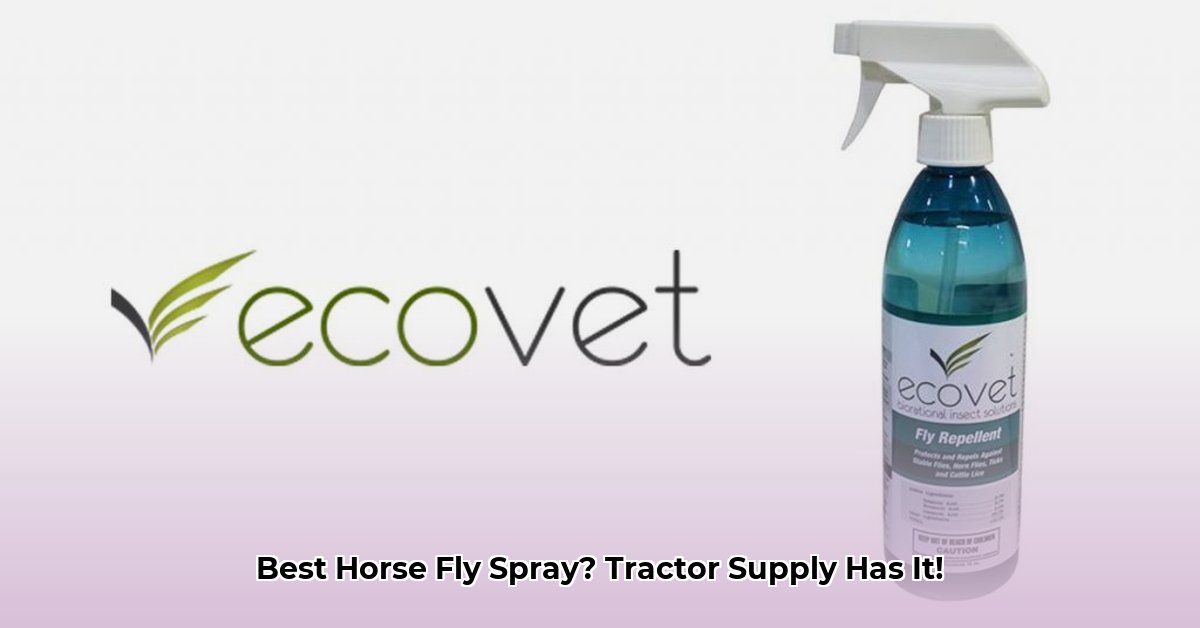
Summer's arrival often brings the unwelcome buzz of horseflies, posing both a nuisance and a potential health risk to your equine companions. Choosing the right fly spray is crucial for keeping your horse comfortable and protected. This guide provides a comprehensive overview of the fly spray options available at Tractor Supply, helping you make informed decisions based on efficacy, environmental impact, and cost. We'll explore chemical and sustainable options, empowering you to select the best solution for your horse and your farm's sustainability goals.
Understanding Your Options: Types of Fly Spray
Tractor Supply offers a variety of fly sprays, each with its own advantages and drawbacks. Choosing the right one depends on your horse's needs, your budget, and your commitment to sustainable practices. Let's break down the options based on application method and active ingredient type.
Application Methods
Aerosols: Quick and easy to apply, providing broad coverage. However, aerosols often require more frequent applications and may have higher environmental impact due to propellant gases. They are best for spot treatments or quick applications over larger areas.
Pour-ons: These are applied directly to the horse's coat, offering a more targeted approach. While convenient, pour-ons may offer less widespread protection compared to aerosols. They are more economical than other methods for large animals.
Backrubbers: Ideal for targeted application to areas where flies congregate, such as the mane and tail. Backrubbers provide longer-lasting protection in those areas but may not cover the entire horse. They are suited for horses that readily rub against the application site.
Dusts: Dusts offer extended protection, and their application is slow-release and relatively long-lasting. However, they can be messy and require careful application to avoid inhalation by your horse. They benefit from being less likely to runoff in wet conditions.
Active Ingredient Types
Chemical Insecticides (e.g., pyrethrins, synthetic pyrethroids): These provide strong protection against flies. While highly effective, they may have greater environmental impacts and some horses may exhibit sensitivities. Always choose products specifically formulated for horses and test a small area first.
Natural Repellents (e.g., citronella, lemongrass oil): These are environmentally friendlier and generally safer for horses. However, their effectiveness might be less potent or have shorter duration than chemical sprays, so more frequent applications may be necessary. Their efficacy varies based on concentration and environmental conditions.
Applying Fly Spray: A Step-by-Step Guide
Safe and effective application is crucial. Always follow the manufacturer’s instructions.
Step 1: Preparation
- Select a calm, well-ventilated area to minimize your horse's stress.
- Equip yourself with protective gear such as gloves and eye protection.
Step 2: Application
- Aerosols: Keep the can 12-18 inches from your horse's coat, applying evenly while avoiding eyes, mouth, and genitals.
- Pour-ons: Part the mane and tail, distribute the liquid evenly along the skin.
- Backrubbers: Apply to high-traffic fly areas like the mane, tail, and chest.
- Dusts: Dust thoroughly, ensuring even distribution while minimizing your horse’s inhalation.
Step 3: Post-Application
- Monitor your horse for any adverse reactions (skin irritation, restlessness). Contact your veterinarian immediately if needed.
Step 4: Storage and Disposal
- Store fly sprays in a cool, dry place, out of reach of children and animals.
- Dispose of empty containers according to local regulations. Reduce, reuse, and recycle whenever possible.
Integrated Pest Management (IPM) for Sustainable Fly Control
IPM combines various strategies for effective and sustainable fly control. Relying solely on sprays is inadequate.
- Eliminate Breeding Grounds: Remove standing water to prevent larval development.
- Employ Fly Traps: These capture adult flies, decreasing their numbers.
- Regular Grooming: This removes eggs and larvae from your horse's coat.
- Strategic Spraying: Use sprays as needed, rotating types to prevent fly resistance. "Rotating spray types can significantly reduce the development of resistance in fly populations," states Dr. Emily Carter, Veterinarian, University of Kentucky College of Agriculture.
Choosing the Right Fly Spray: A Decision Framework
Your choice depends on several factors:
- Budget: Consider the cost per application and duration of effectiveness.
- Environmental Concerns: Opt for natural repellents if minimizing environmental impact is key.
- Fly Population Density: High fly populations may require more potent chemical solutions initially.
- Horse Sensitivity: Test a small area before full application, especially with chemical sprays.
A comparative table (using data specific to Tractor Supply products) would aid in decision-making; however, product-specific data is not available in the current context.
Safety Precautions: Protecting You and Your Horse
- Always read and follow label instructions.
- Keep fly sprays out of reach of children and pets.
- Dispose of empty containers properly.
- Seek immediate veterinary or medical attention in case of accidental ingestion or contact.
By choosing appropriate fly sprays and adopting an integrated pest management approach, you can create a healthier environment and provide optimal protection for your horse. Remember to stay updated on the latest research and adapt your strategies as new options emerge.